
Sleek, small and in need of an outlet
OUR VERDICT
Beware of overpaying for the EliteBook Folio G1: its base configuration has all the pros but the $999 price tag exposes the cost of its cons.
FOR
- Comfortable, enterprise oriented keyboard
- Ultra-thin and light body
- Able multi-tasker
AGAINST
- Adapter hungry
- Finicky touchpad
- Pedestrian battery life
- Base runs extremely hot
If HP’s EliteBook Folio G1 isn’t a complete Windows clone of the Apple MacBook, then it at least takes much inspiration from Cupertino company’s flagship ultraportable. The two laptops share many characteristics: a black-and-silver color palette, an anorexic frame, 12-inch screen size and a belief that “C” is the only worthy letter in the USB alphabet.
There are notable differences, however. The 1080p display of the Folio G1 we tested isn’t as sharp as the MacBook’s Retina display (though a 4K Folio G1 is available), while the shallow-as-a-kiddie-pool MacBook keyboard isn’t nearly as comfortable as the Folio G1’s.
Additionally, the MacBook’s near all-day charge actually meets “Ultrabook” criteria, while the Folio G1 needs to plug in to finish like the weekend warrior who takes a porta potty break every mile of the marathon.
Lastly, at $999 (similar configurations are sold in the UK for £996 and Australia for AU$2,440) the base Folio G1 is cheaper than the $1,299 (£1,249, AU$1,999) MacBook.
With the Folio G1 (and the MacBook), the draw is its design aesthetics: undoubtedly it’s one of the best looking Ultrabooks available. Other recent thin-and-light Windows laptops, like the $1,099 or £999 (about AU$1,450), Lenovo Yoga 900S may offer more ports or even convertibility, but in terms of aesthetics, they are in another, much less luminous galaxy.
However, looks, as my mother says, aren’t everything. It’s what’s inside that counts, right? And the insides of the base Folio G1 are decent : 8GB of memory, a 1080p display and Core m5 processor. Stick with this tier. Thanks to some unignorable flaws, the more you pay for a Folio G1, the less value you’ll receive in return.
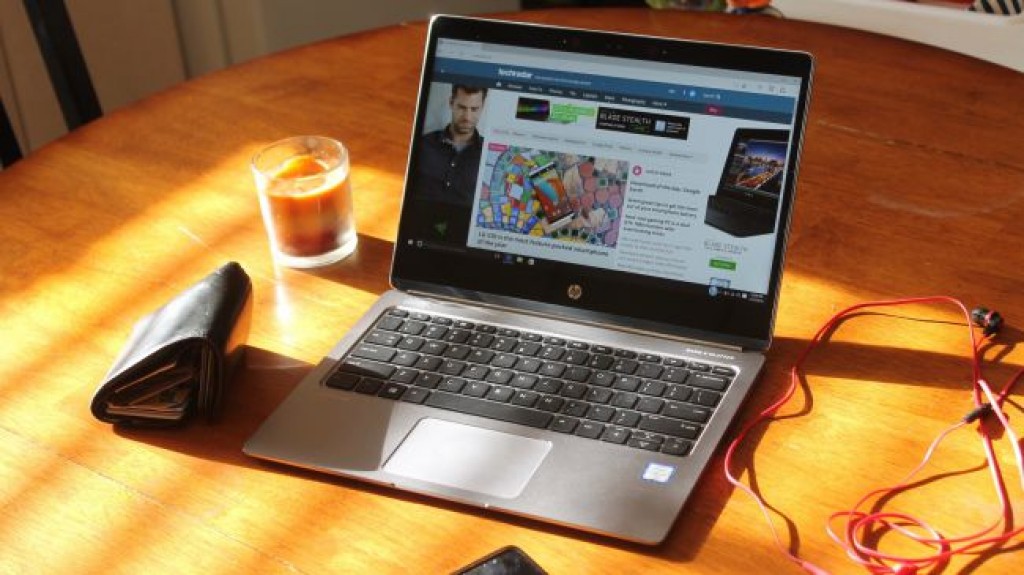
Design
Simple and clean: the mantra of Apple’s HP’s designers.
The EliteBook Folio G1 sports a silver aluminum casing, black bezel and keys, and a noticeable but not untoward hinge. Sound familiar? Teasing aside, the Folio G1 is a great looking device whose design accentuates the important bits: namely how thin and light it is.
At 2.14 pounds, the Folio G1 is a tad lighter than the Yoga 900S (2.2 pounds) and a tad heavier than the MacBook (2 pounds). The Folio is also a tad thinner (0.47 inches) than its two Ultrabook peers (0.50 inches). All these “tads” make the Folio G1 seem unremarkable – until you factor in its price. The base Folio is $300 cheaper than the MacBook and $100 cheaper than the Yoga 900S.
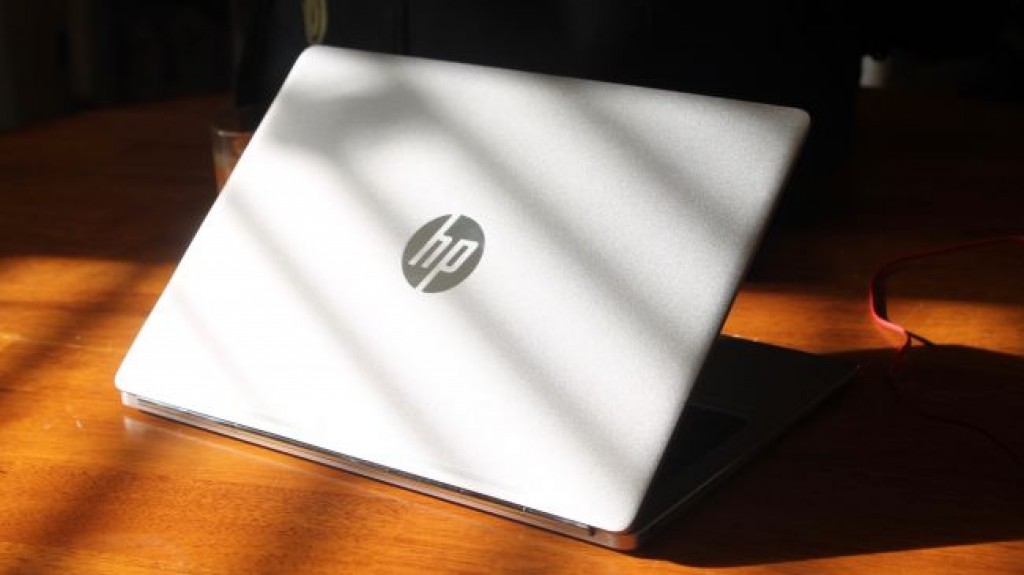
Better as a desktop
The Folio G1 sits on a pair of rubber feet which keep the laptop balanced and stationary, regardless of surface. That said, you won’t want to use the Folio on just “any” surface, particularly your own lap.
That’s because the Folio’s hinge works like a screen door after a liberal dose of WD-40: shift your legs underneath the laptop and the screen will sprawl. Furthermore, the base gets uncomfortably hot after a few hours of use – you’ll feel the heat through a bed sheet, and even pants. All in all, the best place for a Folio G1 is the top of your desk.
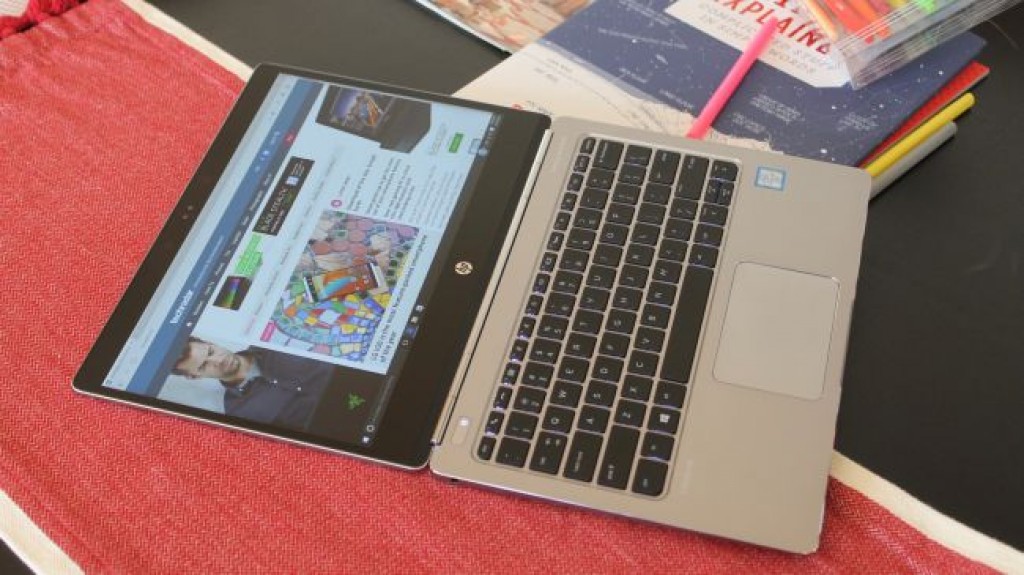
Bezelicious
Because of its extra large bezel, the Folio G1’s screen appears much smaller than its actual 12.5 inch size. The wide top bezel is at least justified by the presence of a webcam and IR camera, but the jumbo bottom reserves space for only a lonely looking HP logo. What gives?
The Folio’s display provides 1920 x 1080 resolution, but the cramped viewing area renders the FHD offering almost superfluous. I can’t imagine upgrading to 4k – it would be downright wasted here.
The Folio’s display also suffers from a blurring/fading issue on the left and right hand sides of the screen. It’s distracting, especially when reading full-screen text. Fortunately, overall viewing angles are crisp even if the glossy screen is prone to glare.

Untouchable
The highlight of the Folio G1 is its keyboard. Backlit and chiclet-styled, the keyboard is an enterprise user’s dream. Despite the limited real estate with which to work, the Folio’s keys are comfortably spaced with excellent travel and uniform feedback across the board.
HP also adds something new to the typical keyboard layout in the form of enterprise-oriented custom function keys. This slight derivation allows for quick access to common business tasks – like calendar management – without the clutter of extra keys.
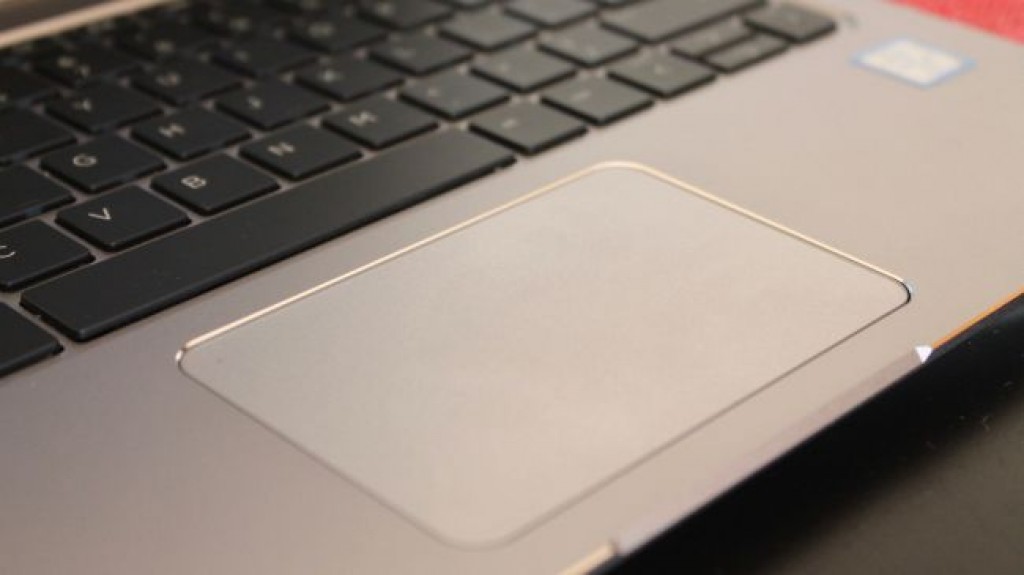
The Folio’s touchpad, on the other hand, is easily its worst feature. The touchpad’s size and location are perfectly fine, as is its “click” feedback, but its multi-touch functionality is incredibly finicky.
Want to two-finger scroll? Nah, we’re zooming. Want to zoom in? Nah, we’re minimizing your browser. Want to minimize? Nah, we’re going into the Upside Down to fight the Demogorgon. These days multi-touch is bog standard on all devices, large and small. Getting it even a little bit wrong is worthy of a furrowed brow.
Here’s the salient stats on the $999 base model Folio G1: Core m5 processor, 8GB of RAM, 128GB of SSD storage, 1080p display (and no IR camera). Our impressive $1,448 configuration beefs up the processor (Core m7), storage (256GB) and includes an IR camera for facial recognition with Windows Hello.
But when compared to the MacBook and Lenovo Yoga 900S, our test model’s stats, from a value perspective, are not as impressive.
The $1,599 (£1,549, AU$2,449) MacBook sports a Core m5 processor and 8GB of RAM – similar to the Folio G1. However, its 2,304 x 1,440 Retina display dwarfs the Folio’s 1080p resolution and 256GB capacity. Pixels aside, the MacBook provides double the gigs (and a small downgrade in processor) for $165 less than the fully spec’d up Folio.
Here the $999 base Folio shows its value. Though it holds four times less data than the MacBook, it’s $300 cheaper. The Folio G1 is also $100 less than the Yoga 900S, and has double the RAM of its Windows competitor.
No port of call
Our Ultrabook rivals significantly diverge in another important area: the number, and diversity, of their ports.
The winner in the game of ports is the Yoga 900S. Though none of the Ultrabooks compared here are particularly “porty,” Lenovo’s has the most with three USB outlets: a 2.0, 3.0 and C. By contrast, the MacBook only provides a solitary USB-C. The EliteBook Folio G1, in its quest to be the best MacBook on the market, offers two USB-Cs.
Apple and HP’s Ultrabooks are thus dongle/adapter dependent. Legacy USB users (i.e. everyone) are right to be irked by this, as it likely adds $25-50 to the purchase price of a MacBook and Folio G1.
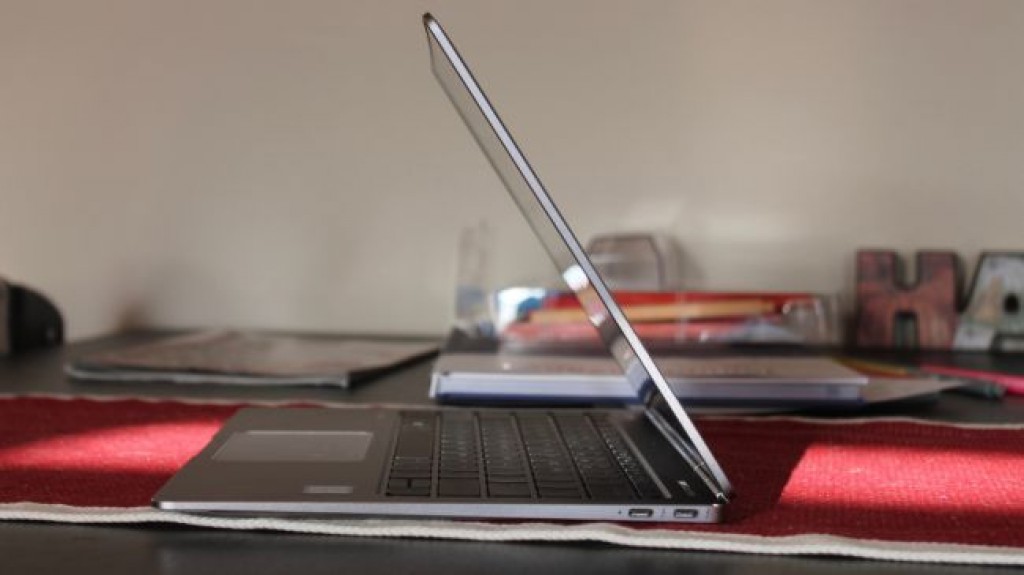
I guess the EliteBook deserves a pat on the back for slotting in two ports, but that praise shouldn’t be anything heartfelt. Since the Folio G1 lacks a dedicated power port and “plugs in” via one of its USB-Cs, when low on battery this laptop has effectively only one port available to it.
Interesting omissions from this supposedly enterprise oriented Ultrabook are a Kensington lock, SD card reader, and fingerprint reader – though HP clearly intends its IR camera and Windows Hello to be the biometric security center for the Folio G1.
This is all the more reason to consider the base EliteBook Folio G1 over other configurations. Outside a bump in storage capacity, the Folio’s higher priced models do not add meaningful upgrades (like more ports) to their spec sheets.
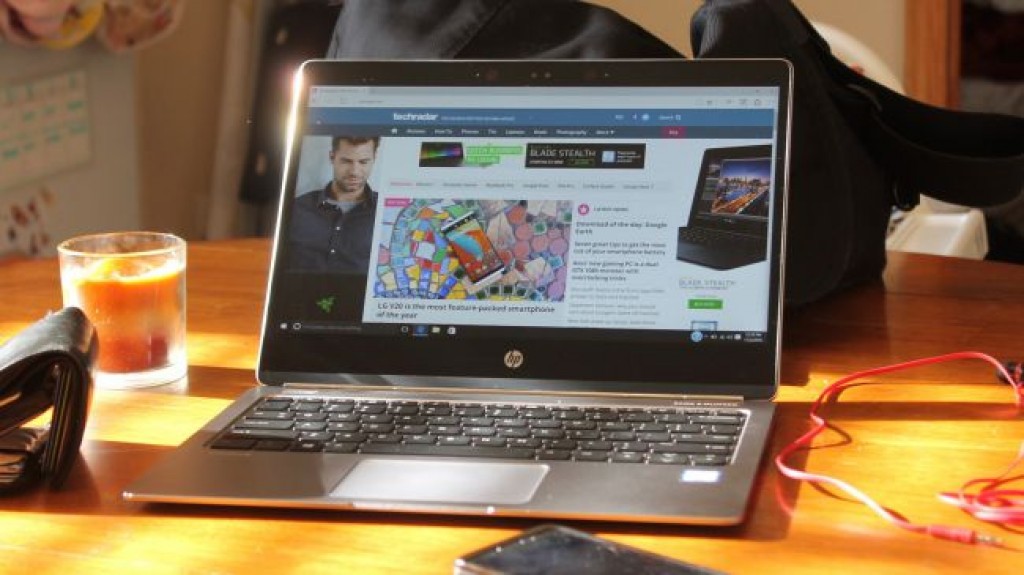
Performance
The Folio G1 we tested was a master multi-tasker: with multiple browsers and programs open and Spotify running in the background, HP’s laptop never stuttered. Also noteworthy: boot up from sleep and total shutdown occurred in seconds, and Windows Hello and the IR camera never misread my face.
Enterprise users should feel confident firing this Ultrabook up for work. In terms of raw, non-battery performance, the Folio does not disappoint.
Benchmarks
Here’s how the HP EliteBook Folio G1 performed in our suite of benchmark tests:
- 3DMark: Cloud Gate: 4486; Sky Diver: 2413; Fire Strike: 684
- Cinebench CPU: 206 cb points; Graphics: 34 fps
- GeekBench: GeekBench: 2860 (single-core); 5522 (multi-core)
- PCMark 8 (Home Test): 2467 points
- PCMark 8 Battery Life: 3 hours and 18 minutes
- Battery Life (TechRadar movie test): 5 hours and 37 minutes
Unsurprisingly, our spec’d up Folio G1, with its 8BG of RAM and a Core m7 processor, shined in our benchmark tests. Its Windows rival, the Yoga 900S, couldn’t match it anywhere (except battery – we’ll get to this). We’ll also note that the Folio G1’s starting spec includes only a Core m5 processor, whose scores would likely fall more in line with the Yoga 900S.
The Folio G1 outperformed Lenovo’s 2-in-1 in all three 3DMark graphics tests: Cloud Gate by 866 points; Sky Diver by 504 points; and Fire Strike by 206 points. On the PCMark 8 Home Test, a hardcore measuring of a laptop’s multi-tasking ability, the Folio bested the Yoga 900S by 264 points, backing up our anecdotal conclusion that the G1 is an excellent choice for enterprise power users.
Against the MacBook, the G1’s performance is a bit middling. Its Geekbench Single Core score is 78 points lower than the MacBook’s, while its Multi Core is 378 points lower. This is particularly interesting as the MacBook runs on a Core m5, a less powerful processor than the Core m7 within our G1 test model. It’s likely that Apple does a better job of integrating its hardware and software than HP.
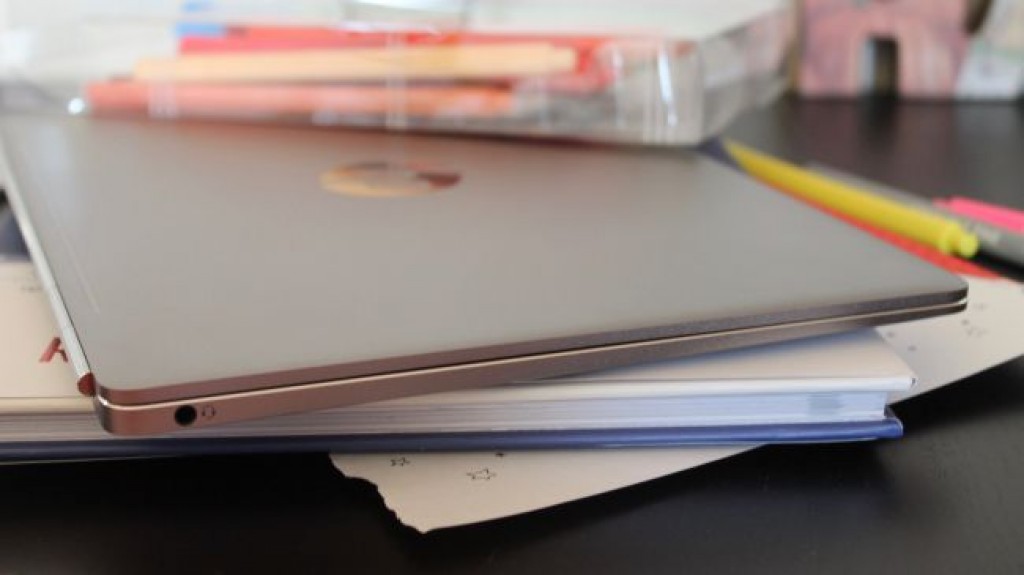
Baddery
The Folio G1 only mustered 3 hours and 18 minutes of charge according to PCMark 8’s battery test – over 3 hours less than the Yoga 900S! And on our anecdotal battery test, where a full screen movie played at 50% brightness and 50% volume, the Folio G1’s battery lasted five and a half hours, underperforming both the MacBook and Yoga 900S by nearly two hours.
The G1’s measly sub-six hour battery falls short of the coveted “all day” (8 hours) uUltrabook goal. Aside from its wacky touchpad, the G1’s poor charge is perhaps its worst “con.” Unfortunately users will have to keep their power cords handy.
Final verdict
The Folio G1’s lack of ports, sub par battery life and bizarre touchpad keep it from being the MacBook killer many thought it would be after its CES 2016 debut.
That said, the Folio G1 improves upon the MacBook’s keyboard, has an extra USB-C port, and the base model is cheaper than Apple’s Ultrabook. Plus day-to-day performance is spot on, a fact that cannot be overstated.
MacBook killer, no, but strong MacBook rival? For sure.
So, in the final analysis, where does HP’s Ultrabook fit? Or perhaps the real question is: which one of the Folio G1’s configurations deserves to be considered?
The tres expensive 4K Folio G1 is a no-brainer to pass on. The 1080p configuration we tested struggled in our battery tests; leaving us to only imagine how much worse the 4k version would perform. And what about the increased storage and processor power also offered in those higher-tier model? They just don’t improve user experience enough to warrant their high costs.
The $999 base EliteBook Folio G1 offers the best overall value: all the “pros” of the device at the cheapest possible price. Not only that, it’s cheaper than the MacBook, the Yoga 900S, and many other Ultrabooks. If you’re looking for a reasonably priced Ultrabook that performs well and looks the part, then the Folio G1 is worth considering.
Sourse: techradar.com










































The product is supposed to be sexy and gorgeous but the photos of the product are grainy, giving the visual impression that the product itself is lousy. I may be mistaken but the photos look typically like those taken from a handphone. Either the reporter is too lazy to carry a proper camera or Tech Radar is not paying its journalists enough to afford an SLR?
Some reference to screen size would’ve been appreciated. Had to go to Cnet to uncover that this was a 12 inch laptop.